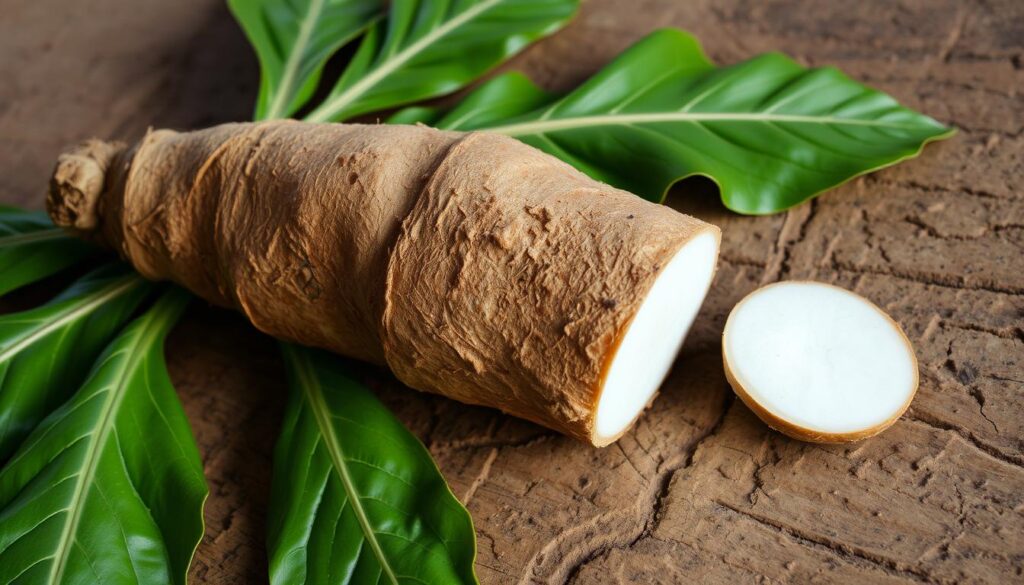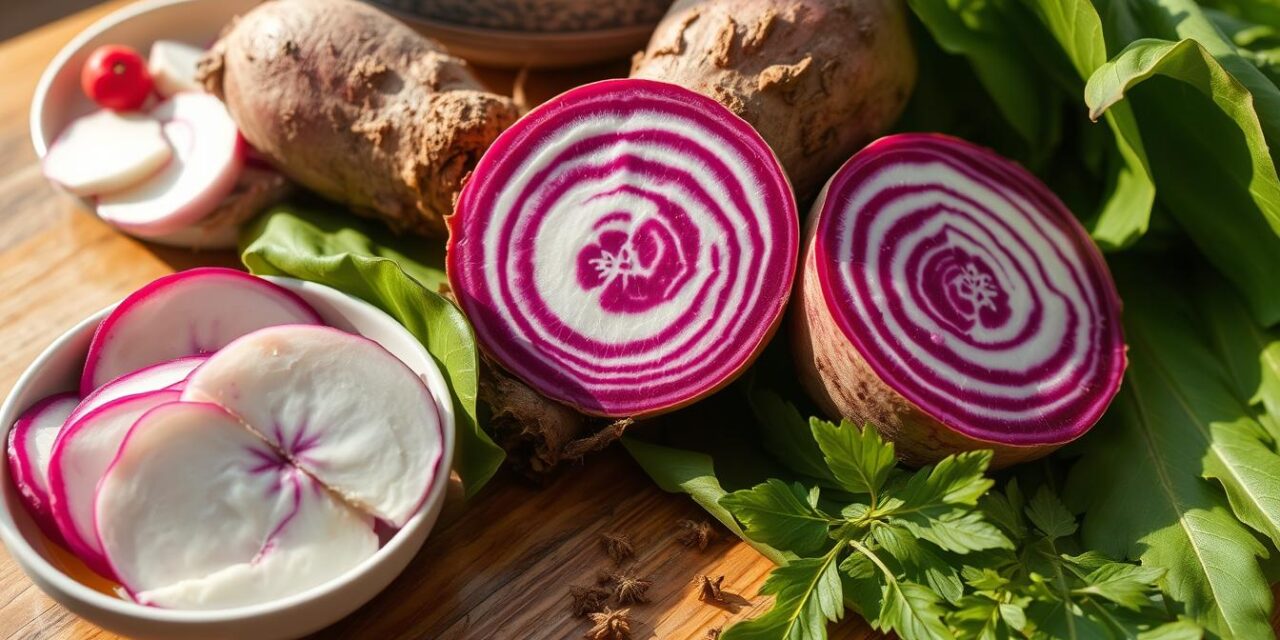Did you know taro root is becoming a big deal in Australia? It’s a starchy tuber with a long history in food around the world. It’s packed with nutrients and could soon be a key part of Australian diets.
Taro root, also called dasheen or eddoe, has been a food staple for centuries. It’s found in the Pacific Islands, Asia, and Africa. This root is full of vitamins, minerals, and fiber, making it great for a healthy diet.
In Australia, people are looking for healthier, sustainable foods. Taro root is getting more attention for its health benefits and versatility in cooking. It’s an ancient crop that’s becoming more popular in the country.
Key Takeaways
- Taro root is a nutrient-dense starchy tuber with a long history in global cuisines
- It is emerging as a popular and healthy food option in Australia
- Taro root is packed with essential vitamins, minerals, and dietary fiber
- Taro’s versatility makes it a valuable addition to modern Australian diets
- Exploring the benefits and uses of taro root can provide Australians with a nutritious and sustainable food choice
Understanding Taro Root: Origin and Botanical Properties
Taro, also known as the “taro corm,” is a staple root vegetable. It has a rich cultural heritage and a remarkable botanical pedigree. Originating from the lush tropical regions of Southeast Asia, this resilient plant has been a dietary mainstay for centuries, nourishing communities across the globe.
Traditional Uses Across Different Cultures
Taro’s versatility has made it a beloved ingredient in traditional cuisines worldwide. From the vibrant taro leaf dishes of the Pacific Islands to the fragrant taro root curries of India, this versatile crop has been a culinary cornerstone for diverse cultures. The taro leaves and corms have been prized for their unique flavors, nutritional benefits, and cultural significance.
Varieties of Taro Plants
The taro family boasts an impressive array of varieties, each with its own distinct characteristics. From the large, starchy “elephant ear” taro to the smaller, more delicate varieties, the taro plant offers a spectrum of textures and flavors. Depending on the region, taro root farming practices have been carefully refined to cultivate the most desirable traits for local cuisines and dietary needs.
Physical Characteristics and Growth Patterns
Taro plants are recognized by their broad, heart-shaped leaves and thick, tuber-like corms that grow underground. These robust plants thrive in warm, humid climates and require ample water to support their lush foliage and sizeable corms. The taro root farming process involves carefully managing the plant’s growth cycle to ensure the optimal development of the prized corms and leaves.
| Taro Variety | Characteristics | Common Uses |
|---|---|---|
| Dasheen Taro | Large, starchy corms with a mild, nutty flavor | Boiled, roasted, or mashed as a staple food |
| Eddoe Taro | Smaller, more delicate corms with a creamy texture | Included in stir-fries, soups, and baked dishes |
| Purple Taro | Vibrant purple-colored corms with a sweet, nutty taste | Used in desserts, beverages, and specialty dishes |
Essential Nutritional Profile of Taro Root
Taro root is a versatile and nutrient-rich tuber. It has a great nutritional profile. This starchy plant is packed with taro root nutrition, offering essential macronutrients, vitamins, and minerals.
Per 100 grams, taro root contains:
- Carbohydrates: 27 grams
- Taro root calories: 112 calories
- Protein: 2.5 grams
- Fat: 0.2 grams
- Dietary Fiber: 4.1 grams
Taro root is known for its low taro root glycemic index of 42. This makes it great for those managing blood sugar levels. It’s also rich in vitamins and minerals like:
- Vitamin B6
- Vitamin C
- Manganese
- Potassium
- Copper
The mix of complex carbs, fiber, and nutrients in taro root makes it a healthy choice. It’s a great alternative to traditional starchy foods.
“Taro root is a nutrient-dense powerhouse, providing a range of essential vitamins, minerals, and beneficial plant compounds.”

Taro Root for Health: Scientific Evidence and Benefits
Taro root is a tuber that’s getting more attention for its health benefits. It’s packed with nutrients that can help your digestion, heart health, and blood sugar control.
Impact on Digestive Health
Taro root is full of dietary fiber, which is great for your digestive system. Research shows it can help with bowel movements, prevent constipation, and keep your gut healthy. It also feeds the good bacteria in your gut, helping your microbiome stay balanced.
Blood Sugar Management Properties
If you’re watching your blood sugar, taro root is worth trying. It has a lot of resistant starch and a low glycemic index. This helps control blood glucose and improve insulin sensitivity. It’s a good choice for a diabetes-friendly diet or keeping blood sugar levels healthy.
Heart Health Benefits
Taro root is good for your heart because it’s full of potassium, magnesium, and antioxidants. Studies show it can lower blood pressure, cholesterol, and heart disease risk. The compounds in taro, like phenols and flavonoids, help protect your heart.

“Taro root’s diverse range of health benefits, backed by scientific evidence, make it a versatile and valuable addition to a balanced diet.”
Comparing Taro Root vs Traditional Potatoes
Taro root and potatoes are both popular root vegetables. They have different nutritional values and uses in cooking. Let’s look at what makes them unique.
Taro root is a favorite in tropical areas. It’s full of vitamins and minerals. It has more fiber, vitamin C, and manganese than potatoes. Taro root also has antioxidants and anti-inflammatory compounds, which are good for health.
| Nutrient | Taro Root (1 cup, cooked) | Potato (1 medium, cooked) |
|---|---|---|
| Calories | 187 calories | 163 calories |
| Carbohydrates | 43g | 37g |
| Fiber | 4.8g | 3.8g |
| Vitamin C | 28mg | 17mg |
| Manganese | 0.5mg | 0.2mg |
The taste and texture of taro root vs. potato are different. Taro root tastes nutty and sweet. It’s firm and great for many dishes, like curries and desserts. Potatoes are more versatile and can be used in many ways.
Choosing between taro root and potatoes depends on what you like and need. Taro root is good for those wanting more taro nutrition. Potatoes are a classic choice for many.

How to Select and Store Fresh Taro Root
Enjoying taro root’s health benefits starts with picking and storing it right. Let’s look at how to keep your taro fresh and full of nutrients.
Storage Best Practices
Store taro root in a cool, dry spot, away from sunlight. The best temperature is 50-70°F (10-21°C). Don’t put taro in the fridge, as it can become hard and change color.
To keep taro fresh, wrap it in a damp paper towel or cloth. Then, put it in a bag with holes or a mesh bag. This keeps the right moisture level and stops taro from drying out.
Signs of Freshness and Quality
- Choose taro roots that are firm and have smooth, unwrinkled skin. Look for no blemishes or soft spots.
- The color should be even, from white to light purple, depending on the type.
- Stay away from taro that looks shriveled, discolored, or has sprouts. These are signs of old age or bad storage.
Handling Precautions
Taro root has calcium oxalate crystals that can irritate skin and cause a burning feeling. Wear gloves when handling raw taro. Also, wash and peel it well before cooking to avoid any irritants.

By following these tips, you can pick and store fresh taro root. This way, you can enjoy its health benefits and tasty uses in cooking.
Preparing Taro Root: Safety and Cooking Methods
Taro root is a versatile and nutritious ingredient. It can be used in many dishes. But, it’s important to know how to prepare and cook it safely.
Preparing Taro Root Safely
Taro root has calcium oxalate, which can irritate the skin. To avoid this, follow these steps:
- Wear gloves when handling the taro to avoid skin irritation.
- Peel the taro root thoroughly, removing the tough outer skin and any blemishes.
- Cut the peeled taro into smaller pieces or slices to aid in cooking and reduce the risk of exposure to the oxalate compounds.
- Soak the prepared taro in water for at least 30 minutes to help remove any remaining oxalate.
Cooking Methods for Taro Root
Taro root can be cooked in many ways. Each method brings out different flavors and textures. Here are some popular methods:
- Boiling: Cut the taro into chunks and boil until tender, about 15-20 minutes.
- Steaming: Place the taro pieces in a steamer basket and steam for 15-20 minutes, or until a fork can easily pierce through the flesh.
- Frying: Slice the taro into thin pieces and fry in hot oil until golden brown and crispy.
- Baking: Toss the taro pieces with oil, salt, and any desired seasonings, then roast in the oven at 400°F (200°C) for 25-30 minutes.
It’s important to watch the taro closely. Adjust the cooking time to make sure it’s cooked right without becoming too soft or mushy.
Preserving Nutrients
To keep taro root’s nutrients, choose cooking methods that don’t lose too much. Steaming or boiling are better than frying or baking. They help keep more of the root’s vitamins and minerals.
“Taro root is a versatile and nutritious ingredient that can be enjoyed in a variety of ways. By following proper preparation and cooking techniques, you can unlock the full potential of this ancient root crop and incorporate it into your everyday meals.”
Incorporating Taro into Modern Australian Cuisine
The culinary scene in Australia is changing, and taro root is becoming a key player. It’s being used in new and exciting ways, pleasing many food lovers. Taro’s versatility makes it a great fit for Australia’s diverse food culture.
Popular Taro-Based Recipes
Australians love taro in many dishes. Taro fritters are a hit, with their crispy outside and soft inside. Another favourite is taro soup, a warm mix of taro, coconut milk, and spices.
For dessert, taro-filled buns and taro bubble tea are all the rage. They appeal to both old and new tastes in Australia.
Dietary Adaptations and Substitutions
- Taro is a great potato substitute, offering a unique taste and creamy feel.
- It’s perfect for vegan and gluten-free diets, adding nutrition to baked goods.
- Its low-GI makes it good for managing blood sugar and finding healthier carbs.
Taro is set to become a staple in Australian cooking. It’s opening up new possibilities in the country’s food scene.
Potential Side Effects and Contraindications
Taro root is usually safe and healthy to eat. But, it’s good to know about possible side effects and when to avoid it. This knowledge helps make sure eating taro is a good choice for your health.
Potential Side Effects
Some people might feel a bit off after eating taro root. This can happen if it’s not cooked right or if you eat too much. The possible issues include:
- Gastrointestinal discomfort, such as bloating, gas, or stomach upset
- Skin irritation or rash, particularly for those with sensitivity to the oxalates present in taro
- Allergic reactions, including itching, swelling, or difficulty breathing, in rare cases
The severity and chance of these side effects can vary. It depends on how sensitive you are, how you prepare taro, and how much you eat.
Contraindications and Precautions
Some people should be careful or not eat taro root at all. This is because of certain health issues or other factors. These include:
- Individuals with kidney or gallbladder issues: Taro root contains high levels of oxalates, which can exacerbate conditions such as kidney stones or gallbladder problems.
- Pregnant or breastfeeding women: Limited research exists on the safety of taro root consumption during pregnancy or lactation, so it’s best to consult with a healthcare provider before incorporating it into the diet.
- Children: Taro root should be introduced with caution in young children, as their digestive systems may be more sensitive to the starch and oxalates present in the vegetable.
If you have a bad reaction or worry after eating taro root, stop eating it. Then, talk to a doctor for advice.
| Potential Side Effect | Likelihood and Severity | Precautions and Recommendations |
|---|---|---|
| Gastrointestinal discomfort | Moderate, common | Introduce taro root gradually, ensure proper preparation and cooking |
| Skin irritation or rash | Low, rare | Discontinue use if skin irritation occurs, consult a healthcare provider |
| Allergic reactions | Low, rare | Discontinue use immediately and seek medical attention if severe reactions occur |
| Kidney or gallbladder issues | High, significant | Avoid consumption if you have pre-existing kidney or gallbladder conditions |
| Pregnancy or breastfeeding | Moderate, limited research | Consult a healthcare provider before incorporating taro root into the diet |
| Children | Moderate, caution advised | Introduce taro root gradually and with supervision in young children |
Knowing about these side effects and when to avoid taro root helps you enjoy its benefits safely. It’s all about looking after your health.
Taro Root Supplements and Powder Forms
There are taro supplements and powder forms available. They make it easy to get the health benefits of taro root. This root is a versatile vegetable.
Usage Guidelines and Dosage
It’s important to follow the dosage on taro supplements. Taro root powder is usually taken in small amounts, 1-3 grams a day. You can add it to smoothies or baked goods.
Start with a small dose and increase as needed. Always talk to a healthcare professional before starting.
Quality Considerations
- Choose taro supplements or powder from high-quality, organic taro root.
- Make sure they don’t have artificial additives or harmful ingredients.
- Look for brands that are open about their making process and have lab test results.
Eating whole taro root is best for getting all its nutrients. But, supplements can be helpful too. Always talk to a healthcare professional before starting any new supplements, especially if you have health issues or take medications.
“Taro root supplements can be a convenient way to incorporate the potential health benefits of this nutrient-dense root vegetable into your daily routine, but they should be used with caution and under the guidance of a healthcare professional.”
Conclusion
The taro root is a remarkable vegetable with a rich history and many health benefits. It has a high nutritional value and is versatile in Australian cuisine. Taro is a true superfood that should be on our plates.
Taro can be enjoyed in many ways, from a starchy staple to creative recipes. It’s also available in supplement form. Taro root supports digestive health, manages blood sugar, and promotes heart health. It’s packed with essential nutrients and beneficial compounds.
In Australia, taro is becoming more popular for its nutritional and sustainable qualities. By embracing taro, we can enhance our diets and celebrate cultural diversity. This remarkable plant offers a wealth of traditional wisdom and health benefits.





